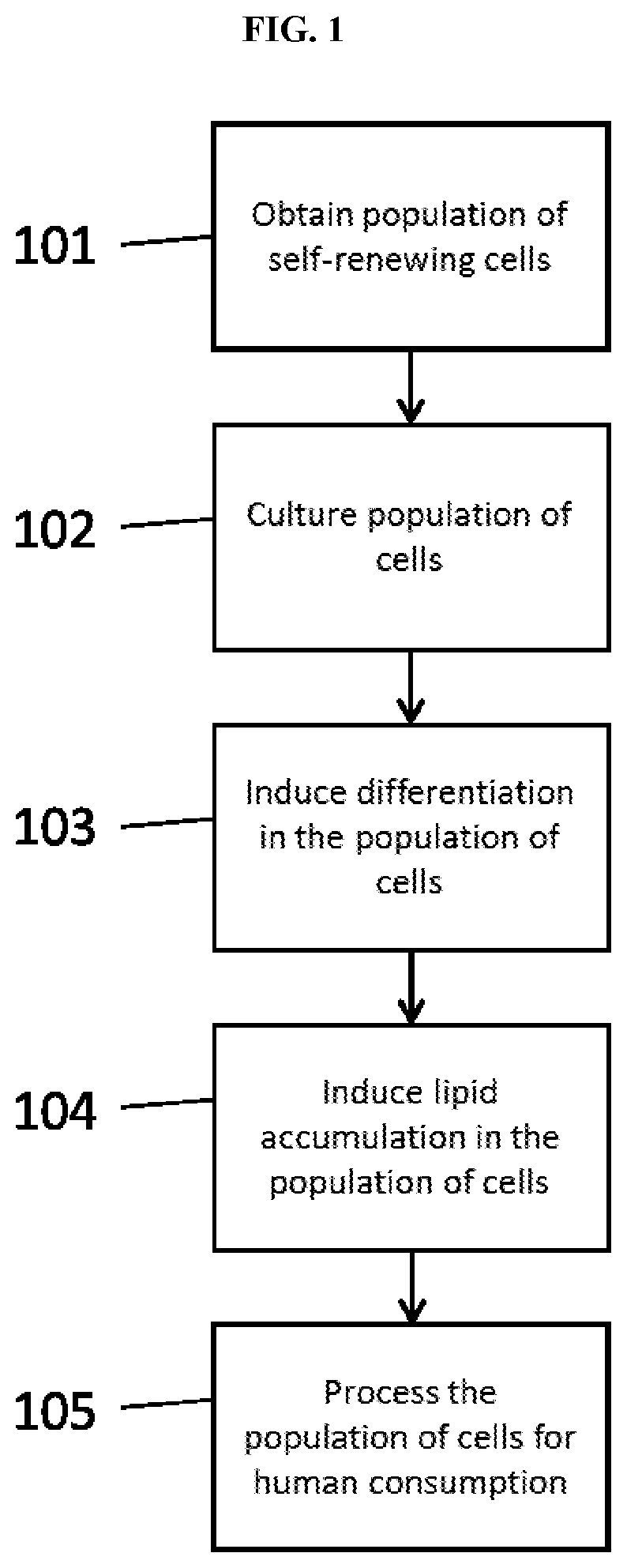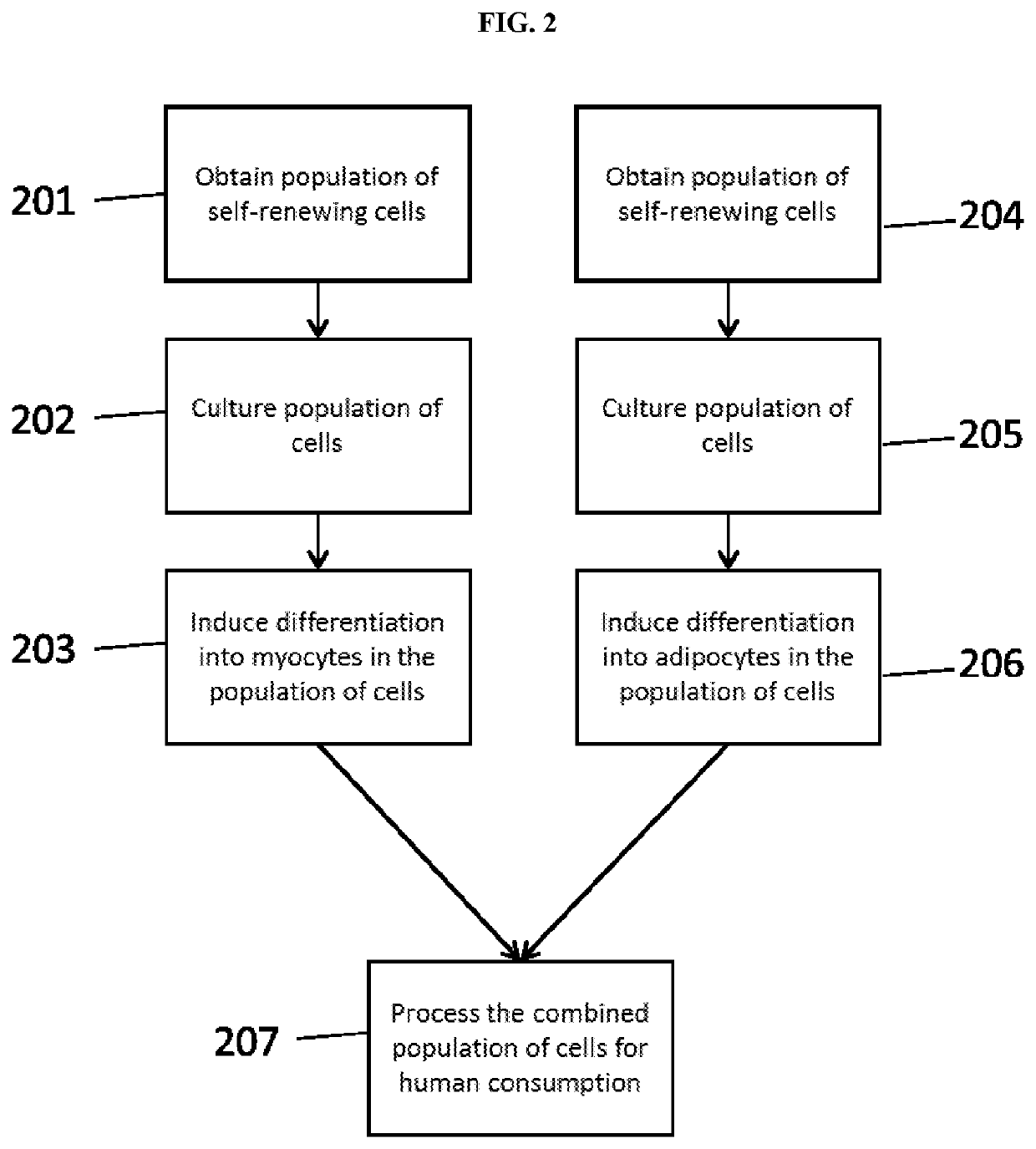Synthetic food compositions
a technology of food compositions and compositions, applied in the direction of biochemistry apparatus and processes, skeletal/connective tissue cells, embryonic cells, etc., can solve the problems of significant environmental footprint, resource-intensive traditional meat production process, and high consumption of fish, and achieve the effect of high formation ra
- Summary
- Abstract
- Description
- Claims
- Application Information
AI Technical Summary
Benefits of technology
Problems solved by technology
Method used
Image
Examples
example 1
Cultured Fish Meat Produced Using Embryonic Stem Cells
[0311]Embryonic stem cells are isolated from salmon embryos. The embryonic stem cells are first cultured using optimized media substrates and media formulations to achieve persistent cellular proliferation and maintenance of the de-differentiated state. The media formulations utilize synthetic serum-free media. The cells are cultured in a pathogen-free cell culture system. Next, the embryonic stem cells are induced to differentiate into myosatellite cells and pre-adipocytes. The myosatellite cells and pre-adipocytes are cultured and expanded to a desired quantity of cells. Next, the myosatellite cells and pre-adipocytes are differentiated into myocytes and adipocytes, which are then harvested and processed by centrifugation and compaction to generate the texture and consistency of fish meat.
example 2
Cultured Fish Meat Produced Using Induced Pluripotent Stem Cells
[0312]Fish fibroblasts are isolated from salmon. An episomal reprogramming strategy is employed to create induced pluripotent stem cells from the isolated fish fibroblasts without the use of classic viral reprogramming techniques. The induced pluripotent stem cells are cultured using optimized media substrates and media formulations to achieve persistent cellular proliferation and maintenance of the de-differentiated state. The media formulations utilize synthetic serum-free media. The cells are cultured in a pathogen-free cell culture system. Next, the iPS cells are expanded to a desired quantity of cells and then induced to differentiate into myocytes and adipocytes. Finally, the myocytes and adipocytes are harvested and processed by centrifugation and compaction to generate the texture and consistency of fish meat.
example 3
Cultured Fish Meat Produced Using Direct Cell Reprogramming
[0313]Differentiated fish fibroblasts are isolated from salmon. The fibroblasts are serially passaged until a cell line is selected that has capacity for continuous self-renewal (e.g., immortalized). The immortalized fibroblasts are grown in culture to a desired quantity, and then transdifferentiated. A reprogramming strategy using the overexpression of select genes is employed to directly reprogram the fibroblasts into myocytes and adipocytes without creating an intermediate pluripotent cell type. Accordingly, transdifferentiation allows for the immortalized fibroblasts to be converted into the desired cell type without requiring the use of stem cells.
PUM
| Property | Measurement | Unit |
|---|---|---|
| Composition | aaaaa | aaaaa |
| Shape | aaaaa | aaaaa |
| Polymeric | aaaaa | aaaaa |
Abstract
Description
Claims
Application Information
 Login to View More
Login to View More - R&D Engineer
- R&D Manager
- IP Professional
- Industry Leading Data Capabilities
- Powerful AI technology
- Patent DNA Extraction
Browse by: Latest US Patents, China's latest patents, Technical Efficacy Thesaurus, Application Domain, Technology Topic, Popular Technical Reports.
© 2024 PatSnap. All rights reserved.Legal|Privacy policy|Modern Slavery Act Transparency Statement|Sitemap|About US| Contact US: help@patsnap.com










